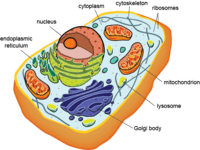
Cell Test Review 1
Quiz
•
Biology
•
7th Grade
•
Easy
ELISE RANDLE
Used 1+ times
FREE Resource
13 questions
Show all answers
1.
MULTIPLE CHOICE QUESTION
30 sec • 1 pt
What is the function of the nucleus in a cell?
Cell wall formation
Energy production
Waste storage
Control center of the cell
2.
MULTIPLE CHOICE QUESTION
30 sec • 1 pt
Name the organelle responsible for producing energy.
Ribosomes
Mitochondria
Nucleus
Endoplasmic Reticulum
3.
MULTIPLE CHOICE QUESTION
1 min • 1 pt
Explain the process of photosynthesis and its importance in the cell.
Photosynthesis is the process of converting oxygen into carbon dioxide, which is harmful to the cell.
Photosynthesis is the process of breaking down glucose to release energy, which is not important for the cell.
Photosynthesis is the process of using water and carbon dioxide to produce nitrogen, which is not needed by the cell.
Photosynthesis is the process by which plants use sunlight to create food. It is important in the cell as it produces oxygen and glucose, which are essential for the survival of the cell.
4.
MULTIPLE CHOICE QUESTION
30 sec • 1 pt
What is mitosis and why is it important for growth and repair in multicellular organisms?
Mitosis is only important for single-celled organisms.
Mitosis is the process of cell division that allows for growth and repair in multicellular organisms.
Mitosis is the process of cell death in multicellular organisms.
Mitosis is a type of photosynthesis in multicellular organisms.
5.
MULTIPLE SELECT QUESTION
30 sec • 1 pt
What are TWO examples of passive transport?
Osmosis
Exocytosis
Endocytosis
Diffusion
6.
MULTIPLE CHOICE QUESTION
1 min • 1 pt
Describe the process of diffusion and its role in maintaining cellular balance.
Diffusion is the movement of particles from an area of high concentration to an area of low concentration. It helps maintain cellular balance by allowing substances like oxygen and nutrients to enter the cell, and waste products to exit.
Diffusion is the movement of particles from an area of low concentration to an area of high concentration. It only allows harmful substances to enter the cell and prevents essential nutrients from entering.
Diffusion is the movement of particles from an area of high concentration to an area of low concentration. It has no role in maintaining cellular balance.
7.
MULTIPLE CHOICE QUESTION
30 sec • 1 pt
What is active transport and how does it differ from passive transport?
Active transport requires energy and passive transport does not require energy.
Active transport requires no energy and passive transport requires energy.
Create a free account and access millions of resources
Similar Resources on Wayground

17 questions
Cell Parts (2022)
Quiz
•
6th - 8th Grade

17 questions
Y7 - cells and microscopes
Quiz
•
7th Grade

17 questions
7.12(D) Cell Structure & Function
Quiz
•
6th - 8th Grade

14 questions
Cell Parts
Quiz
•
6th - 8th Grade

10 questions
Cells to Human Body Systems
Quiz
•
7th Grade

17 questions
The Cell.
Quiz
•
6th - 7th Grade

17 questions
Organelle
Quiz
•
7th - 9th Grade

14 questions
KS3 Cells Review
Quiz
•
7th Grade
Popular Resources on Wayground

10 questions
Video Games
Quiz
•
6th - 12th Grade

20 questions
Brand Labels
Quiz
•
5th - 12th Grade

15 questions
Core 4 of Customer Service - Student Edition
Quiz
•
6th - 8th Grade

15 questions
What is Bullying?- Bullying Lesson Series 6-12
Lesson
•
11th Grade

25 questions
Multiplication Facts
Quiz
•
5th Grade

15 questions
Subtracting Integers
Quiz
•
7th Grade

22 questions
Adding Integers
Quiz
•
6th Grade

10 questions
Exploring Digital Citizenship Essentials
Interactive video
•
6th - 10th Grade
Discover more resources for Biology

18 questions
Cell theory & Scientists
Quiz
•
7th Grade

10 questions
Digestive System
Quiz
•
5th - 8th Grade

28 questions
Unit 1 Ecology: Quiz 3 LF, CC, and Biomes
Quiz
•
7th Grade

18 questions
Human Body Systems
Quiz
•
7th Grade

7 questions
Human Impact on Resources
Interactive video
•
4th Grade - University

20 questions
cell theory and organelles
Quiz
•
6th - 8th Grade

25 questions
Mitosis and Meiosis
Quiz
•
6th - 8th Grade

10 questions
Cells, Cells, Cells
Quiz
•
7th Grade

